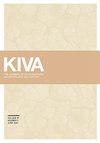铅和锌颜料壁画油漆:在科罗拉多州西南部的洛瑞普韦布洛大房子发现古代技术
IF 0.4
0 ARCHAEOLOGY
Kiva-Journal of Southwestern Anthropology and History
Pub Date : 2022-08-16
DOI:10.1080/00231940.2022.2103902
引用次数: 1
摘要
在Lowry Pueblo,彩绘石膏的小碎片是曾经装饰Kivas a和b的大胆的白色阶梯图案壁画的全部遗迹。我们使用以下分析技术来研究这些碎片:视觉显微镜分析,便携式x射线荧光,带有能量色散x射线光谱仪的扫描电子显微镜,粉末x射线衍射和放射性碳定年。我们在光泽白色涂料中鉴定出氧化锌和硫酸铅颜料矿物,而在哑光白色涂料中鉴定出碳酸钙颜料。铅层的放射性碳年代测定表明,壁画的制作时间为公元1030-1210年,与洛瑞普韦布洛大宅的占领时间一致。对粉刷石膏层的地层学分析表明,在最终的哑光白色层之前,底层有光泽的白色油漆被应用。颜料来源和颜料配方的变化表明了kiva画家对设计的修改选择。本文章由计算机程序翻译,如有差异,请以英文原文为准。
Lead and Zinc Pigmented Mural Paint: Discovering Ancient Technologies at Lowry Pueblo Great House in Southwest Colorado
At Lowry Pueblo, small fragments of painted plaster are all that remain of a bold white step pattern mural that once decorated Kivas A and B. We used the following analytical techniques to study these fragments: visual microscopic analysis, portable X-ray fluorescence, scanning electron microscopy with an energy dispersive X-ray spectrometer, powder X-ray diffraction, and radiocarbon dating. We identified zinc oxide and lead sulfate pigment minerals in the glossy white paint, whereas calcium carbonate was identified as the pigment for the matte white paint. Radiocarbon dating of a lead layer places mural production at 1030–1210 cal A.D., consistent with occupation at Lowry Pueblo Great House. Stratigraphic analyses of the painted plaster layers reveals that underlying glossy white paint was applied before the ultimate matte white layer. The change in pigment source and paint recipes demonstrate a design-modifying choice made by the kiva painters.
求助全文
通过发布文献求助,成功后即可免费获取论文全文。
去求助
来源期刊
CiteScore
0.70
自引率
33.30%
发文量
31

 求助内容:
求助内容: 应助结果提醒方式:
应助结果提醒方式:


